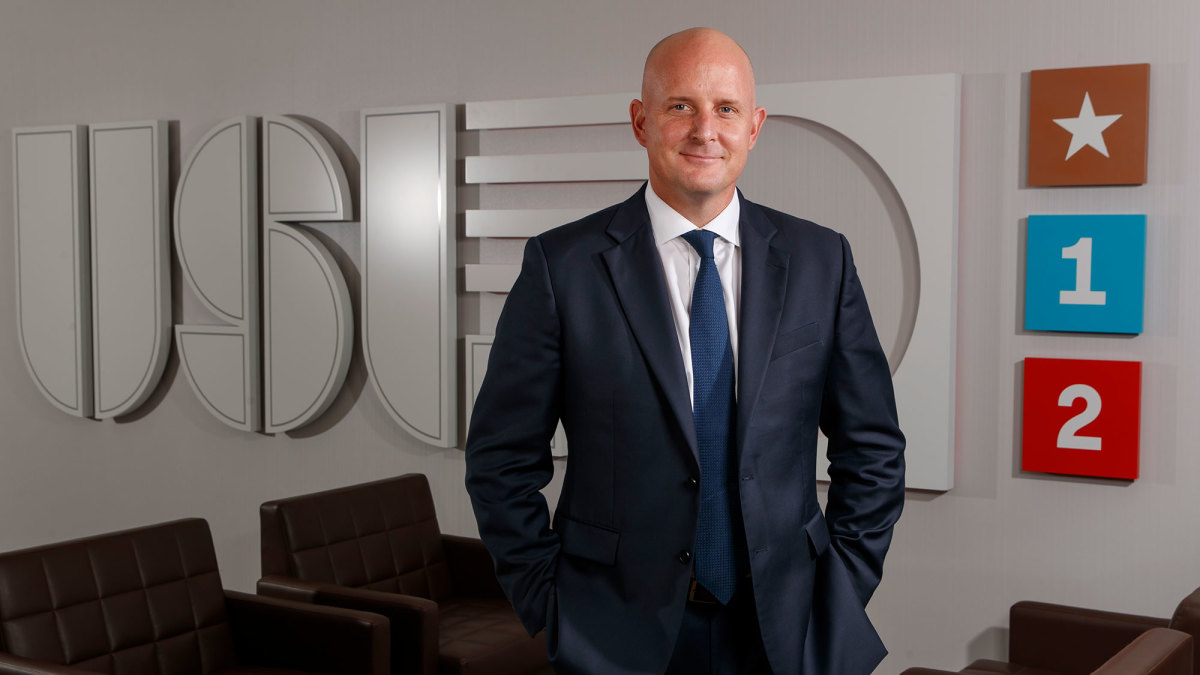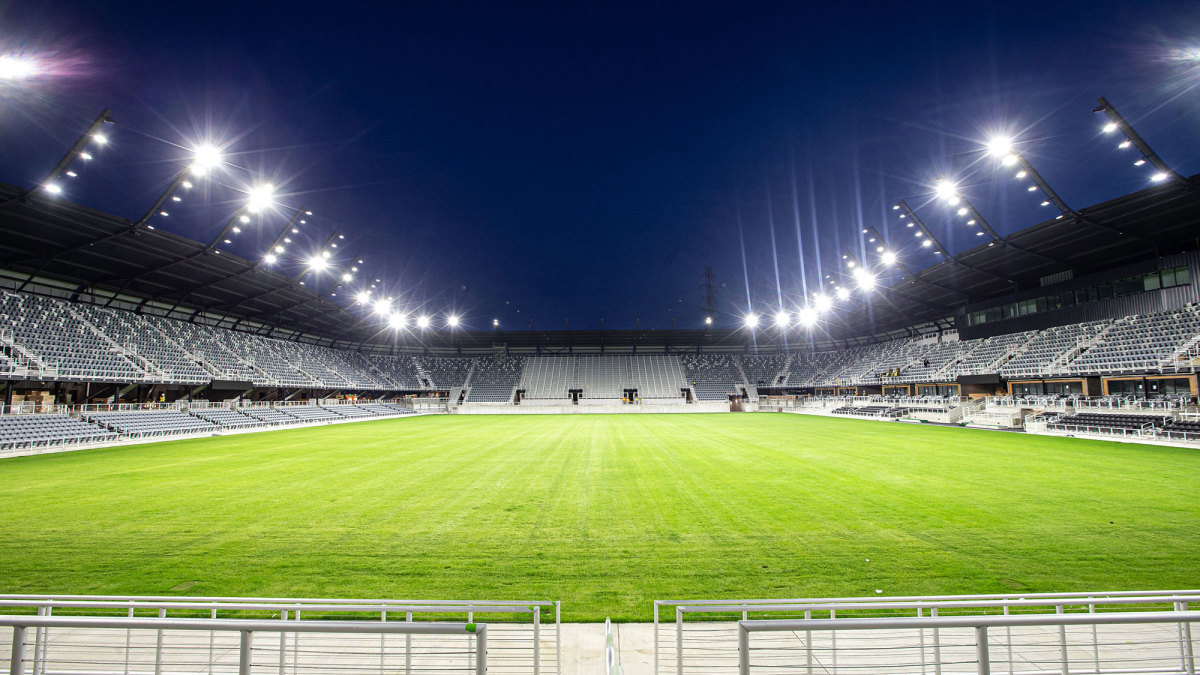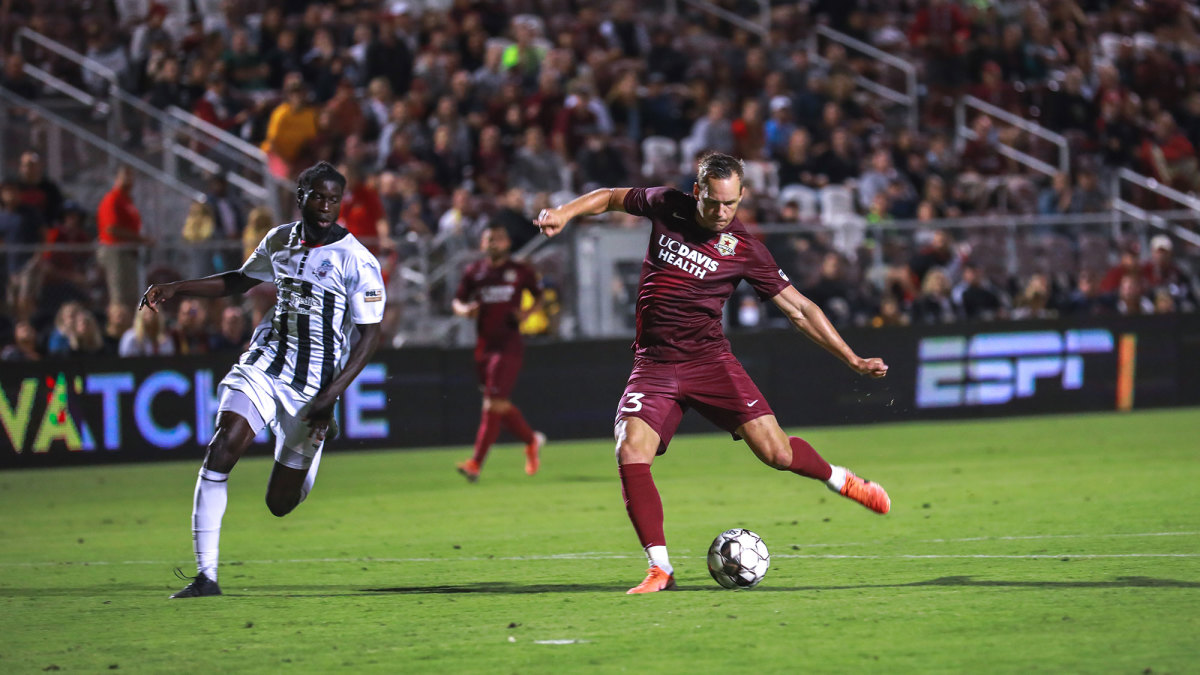The Varying Degrees of Coronavirus's Impact on U.S. Soccer's Lower Club Tiers

For the fortunate, the impact of the coronavirus is intangible, or simply inconvenient. Eventually, however, even inconvenience can become existential. Like the virus, it starts relatively small. For example, consider the front of Union Omaha’s jersey.
Like most teams its size, the expansion USL League One club can’t count on broadcast revenue. And it’s going to share a stadium with a minor league baseball team. Union’s most valuable single asset, therefore, is the ad space on the front of its shirt.
“We had the jerseys ready to go. We had the stock ready to sell, the sleeve partner—everything was ready to go and all we needed to do was sign the deal with the jersey partner,” Union COO Matt Homonoff said of the club’s preparation for its kit unveiling. “Then the week everything blew up, the two finalists to be on the front pulled out at the same time because everything went to hell.”
It was a financial gut punch, and a part of a cascade of pandemic-related events that ruined the start of Omaha’s inaugural season. To its credit, the soccer team called an audible, and last week, it released its home and away jerseys with the front donated to a pair of local healthcare organizations (along with a portion of the sale proceeds).
The money that would’ve been earned through a season-long sponsorship can’t be recovered. But if the publicity and attention help flatten the curve, and if the goodwill deepens the new club’s relevance and connection to the community, then the space will have been put to good use. For Union Omaha and so many other lower-league clubs, only the right combination of ingenuity and austerity will see them through this unprecedented challenge.
Most of the focus this month, as usual, has been on how major league, top-tier sports will handle these challenges. Who will be crowned and relegated in Europe? When and how will the NHL and NBA finish their seasons? Will Tokyo be able to stage the Olympics next year? Which NFL coach will trip on an extension cord and forfeit his team’s draft pick?
But for those organizations, the pandemic is more inconvenient than existential. They’re multi-billion dollar businesses with massive TV rights deals, as well as large fan and sponsorship bases, that are built to weather this storm. Even MLS, which is much smaller than the aforementioned outfits and far more dependent on game-day revenue, has the billionaire boardroom and infrastructure needed to survive.
It’s a different sort of ecosystem further down the pyramid and especially so in the lower levels of American soccer, where there are five national leagues (three pro and two amateur). Not only do they lack the revenue and financial cushion of their top-tier counterparts, most of the soccer clubs in the USL, NISA and NPSL don’t have any sort of connection to a major league franchise.
Union Omaha’s partner, the Pacific Coast League’s Storm Chasers, are the AAA affiliate of the Kansas City Royals and know their player and coaching costs, among other expenses, will be handled by the parent club. But Omaha—like six of its League One brethren, 26 of the 35 USL Championship teams and each of the eight pro clubs expected to play this spring in NISA—must make do almost entirely on its own.
“This league is a set of communities that are dependent on each other and will rise and fall together. With that in mind, we have to be as flexible as possible with our clubs to help them navigate through this,” USL president Jake Edwards said. “The USL, like other sports leagues, is feeling the pain. This is going to hurt. We are going to take a few lumps. We’ve had to adjust.”

An unspecified portion of USL’s front office staff in Tampa has been furloughed, Edwards confirmed.
“They’re primarily on our youth properties that might not be running this year, or some of our events team. We’ll bring them back once we’re back in a normal state. But that hurts. That’s a tough thing,” he said.
Those who remain are working with individual teams, facilitating conference calls and conversations, and trying to figure out how and when teams can take the field again. Edwards told Sports Illustrated that the current target is July. That probably won’t be soon enough to save the League Two campaign, which typically ends in August as players return to college. In fact, six of the amateur circuit’s clubs based in New York and New Jersey already have terminated their seasons. The NPSL, the country’s other national amateur league, pulled the plug on 2020 last month.
A best-case scenario July return for the USL Championship and League One also probably won’t leave enough room to accommodate participation in the U.S. Open Cup. Edwards said the USL doesn’t foresee entering the competition this year.
The reality driving the Open Cup decision, along with the staff furloughs and layoffs at Union Omaha and approximately 15 other Championship and League One clubs, is grounded in the economy of lower-tier soccer. It’s an on-site, game-day business.
“It’s probably about 75% [of revenue] comes from sponsorship and ticket sales,” Edwards said. “You can break your ticket sales into advance and walk-up, and then all the match-day spend while they’re there. The sponsorships are linked to the amount of games. So you’re looking at a significant portion.”
Therefore, for the vast majority of Championship and League One teams—and NISA as well—staging a season behind closed doors isn’t practical. And so the longer this drags on, the more existential the decision becomes.
“There’s a risk that if you miss an entire season of match-day revenue, and potentially what else is going on with other businesses that the owner may be operating, there is that risk,” Edwards said. “It’s obviously a threat, not just to teams in our league but across the world, and that’s the reality of it. The sooner we get playing again the better. We are bullish we’ll be kicking off mid-summer.”
The Championship and League One do have a broadcast deal with ESPN worth more than $1 million. But once divided among the league office and each club, that money doesn’t go very far. In addition, teams have to help foot the production costs, so without the revenue provided by fans, staging games often would wind up resulting in a financial loss. That’s on top of player salaries, which are guaranteed.
Homonoff said Union had to kick in a one-time payment of $25,000 to VISTA Worldlink, the production company contracted by the USL, and then an additional $6,000 per game played.
“It’s one of many expenses that makes playing behind closed doors the ultimate nonstarter,” he said. “Just opening the gates to the stadium, you have expenses—staff, electricity, cleaning. You wouldn’t have the costs associated with food and [staffing] the concourse, but you also don’t have any revenue … There’s no model that anyone’s been able to put forward that works from an independent team’s perspective.”
Chattanooga FC chairman Tim Kelly said that his NISA club, among others, is toying with the idea of asking fans to “pay a couple bucks to watch a game streamed,” in order to offset some of those match-day expenses. NISA is a new third-tier league that played an abbreviated schedule last fall and hoped to establish some national traction in 2020 with the spring addition of Chattanooga and Detroit City and then the autumn arrival of the New York Cosmos.
Concluding the 2019-20 NISA season now appears to be almost impossible, but the potential streaming fee highlights the way its teams might approach the pandemic. Rely on your roots. Chattanooga literally is a community-oriented club—around 3,300 fans paid nearly $1 million to buy small shares in the team. NISA teams aren’t beholden to a central league authority, but they also don’t receive the support that anchor might provide.
“I was quite worried about it. The irony is that the franchise model, as much as we dislike it, has the advantage of central control and kind of the [strength] of running out of the Death Star. Our premise is that we’re like the Rebels. We’re scattered all over the place. Clubs have their own approaches and motivations. So that central stability isn’t really there,” said Kelly, who helped launch CFC as an NPSL club back in 2009.
“So there was real cause for concern going into this,” he concluded. “But the [NISA] office has been quite good about making the most of the time to think strategically about how we can sharpen our message about the importance of independent clubs and community-based clubs. I think the league will be fine.”
At the other end of the lower-tier spectrum, there are the clubs that are essentially major league, or close to it. New Mexico United, Indy Eleven and Sacramento Republic attract average attendances in the five figures. Louisville City is on the verge of opening a new $65 million, $12,000-seat stadium. The Colorado Springs Switchbacks have also broken ground on a new venue.

A few Championship teams drive substantive revenue from local TV deals, and a handful have been eying ascension into MLS. The aforementioned clubs, along with the likes of Phoenix Rising, San Diego Loyal and the Tampa Bay Rowdies, may play in the same league as more modest USL outfits, but they’re in a different league in many ways.
These are teams that give the USL stability and pro legitimacy, and the ones that “can help some of the new clubs understand that there is a way through this,” Edwards said. But they’re also the clubs that are far less concerned with survival, and which eventually might advocate to play behind closed doors.
“Sacramento Republic cannot exist by itself. Who would we play? We rely on each other, and in some ways this makes it harder,” Republic president and COO Ben Gumpert said. “Even in the hotel industry or something like that, if one geographic area opens up they can open up hotels in California, or pick your state—roll it out. In a league, you can’t do that. We all need each other to work and succeed.
“This is incredibly complicated, and it’s complicated for everybody,” he continued. “There’s a lot of variability, but rest assured that happens in all leagues. There’s big-market teams, big-revenue teams, and then teams that have more people affected by this. You can’t solve team-by-team or even state-by-state. You need to solve it across the board.”
Sacramento is scheduled to join MLS in 2022 and is eying the pandemic’s impact on its downtown stadium construction project as much as on the 2020 USL schedule. It has the front office experience and the sort of sponsorships and long-term partnerships that will see the club through this period; however, Republic also has the only confirmed coronavirus case among USL players. The virus does not discriminate between big and small teams, and it highlights the fact that some risk remains to playing even without fans. A closed-door game involves athletes, coaches, trainers, medical personnel, club and stadium staff, media, referees and others who might spread or catch the disease.
Republic was ready for the positive test, Gumpert said, thanks to assistance from its primary sponsor, UC Davis Health. The affected player, whose identity hasn’t been released, has recovered.
“There’s a lot that we went through. We went through every step in the process including contact tracing. That includes isolation. That includes quarantine for two weeks. We went through that including all our players and everyone on our staff that could’ve been exposed,” Gumpert said.
“We’d be doing ourselves a disservice if we didn’t do some amazing diligence first and foremost, when discussing returning to the field,” Gumpert added. “Let’s understand what’s safe and what makes sense for the long-term health of the league, what’s best for the long-term health of this community and this club.”

The irony of all this, of the timing of the pandemic and its impact on the USL and NISA’s emergence, is that American lower-tier soccer had never been healthier. The days of clubs forming and folding in the blink of an eye are long gone. Although some have denounced the U.S. Soccer Federation’s pro league standards, it’s hard to argue that the minimum net worth requirement for team owners hasn’t created more stability.
Growth has followed, and the spaces in the map between MLS franchises are gradually being filled in. In 2010, there were 12 teams competing at the second-division level. This year there are scheduled to be 35. While Fresno (Championship) and Lansing (League One) folded after 2019, new Championship teams in Buffalo, Des Moines, Oakland and Providence are in the works. And Edwards said the USL is having conversations with 51 communities about membership in League One, where the expansion fee hovers around a much more affordable $1 million. Meanwhile, NISA has commitments from five new teams, including the Cosmos.
It seems like there’s enough momentum there to power through this pandemic, even if there are losses on the margins. Some League Two or NPSL clubs might not make it, but there’s always been more volatility at that level. Whatever friction might ensue between the bigger and smaller clubs in the Championship and League One/NISA is pretty much inevitable. That’s what happens when you play in front of 10,000 one week and at an MLS 2 team with 500 fans the next. And it’s a hallmark of competitions across the globe. Different clubs have different resources and priorities. But that friction doesn’t have to define this strange, challenging year in lower-league soccer. In many quarters, after all, the virus has helped reshape perspective.
“We have regular communication as a group with owners and in times like this, one thing that does differentiate a lot of American sports leagues from leagues around the world is that there’s a real sense of collective among the ownership and a high level of participation,” Edwards said. “This crisis has brought with it a collective sense of unity and we face a massive challenge. But if we stick together there is a way out.”
In Omaha, Homonoff said there was concern as things started to unravel. Creating the club had been a three-year project, and it was just at the finish line—or starting line, depending on how you look at it—that the doors began to slam shut. The jersey sponsorship was lost. Season ticket orders slowed. There was a player, midfielder Tobias Otieno, stuck in Kenya. And the big St. Patty’s at the Park festival at the Werner Park stadium—the kickoff event for Union and the Storm Chasers—was canceled with less than 48 hours to go.
“It was the worst,” he said of those first few days.
Then he noticed that the festival T-shirts didn’t have the year on them. Union can use them in 2021. It was a welcome good omen when one was needed.
“At the beginning I think it was natural for everyone to be worried about teams and their long-term future,” Homonoff said. “But after going through the last month where we are on calls and communicating with every team around the league, I’m less concerned now because of the obvious interest they show in finding the right solutions based on their business models.
“There’s no way a team that’s getting ready to fold is going to spend the time asking those question and trying to find these solutions,” he added. “I can’t speak for another team, but our owners are in it for the long haul, and based on everything I’ve heard from other teams, they're all in it for the long haul.”
